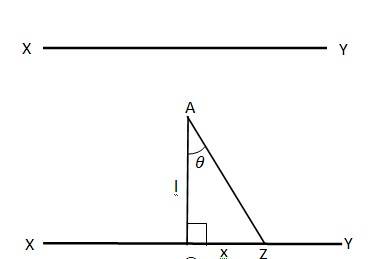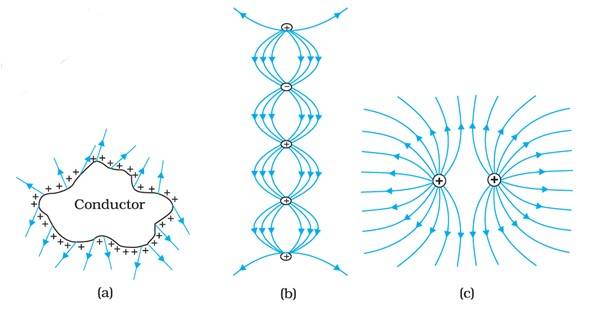Electric Charges and Fields
Get insights from 101 questions on Electric Charges and Fields, answered by students, alumni, and experts. You may also ask and answer any question you like about Electric Charges and Fields
Follow Ask QuestionQuestions
Discussions
Active Users
Followers
New answer posted
6 months agoContributor-Level 10
1.34 Velocity of the particle, = 2.0 m/s
Separation of the two plates, d = 0.5 cm = 0.005 m
Electric field between two plates, E = 9.1 N/C
Charge of an electron, q = 1.6 C
Mass of an electron, = 9.1 kg
Let the electron strike the upper plate at the end of the plate L, when deflection is s. Therefore
s =
L = = =
= 0.0158 m = 1.58 cm
Therefore, the electron will strike the upper plate after travelling 1.58 cm.
New answer posted
6 months agoContributor-Level 10
1.32 (a) Let the equilibrium of the test charge be stable. If a test charge is in equilibrium and displaced from its position in any direction, then it experiences a restoring force towards a null point, where the electric field is zero. All the field lines near the null point are directed inwards towards the null point. There is a net inward flux of electric field through a closed surface around the null point. According to Gauss's law, the flux of electric field through a surface, which is not enclosing any charge, is zero. Hence, the equilibrium of the test charge can be stable.
(b) Two charges of same magnitude and same sign a
New answer posted
6 months agoContributor-Level 10
1.31 A proton has 3 quarks. Let there be n 'up quarks', then number of 'down quarks' = 3-n
Charge due to n 'up quarks' =
Charge due to (3-n) 'down quarks' =
Total charge on a proton = +e =
e =
2e =
n = 2
Number of 'up quark' = 2 and number of 'down quark' = 1. Therefore a proton can be represented as 'uud'.
A neutron has 3 quarks. Let there be n 'up quark' in a neutron and (3-n) 'down quark'
Charge due to n 'up quark' = +
Charge due to (3-n) 'down quark' =
- (
Since total charge of a neutron is zero, we get
+
en = e or n = 1
Hence number of 'up quark' in neu
New answer posted
6 months agoContributor-Level 10
1.30

Take a long thin wire XY of uniform linear charge density
Q =
Electric field due to the piece,
dE = =
The electric field is resolved into two rectangular components. dE
Hence
New answer posted
6 months agoContributor-Level 10
1.29 Let us consider a conductor with a cavity or a hole. Electric field inside the cavity is zero. Let E be the electric field outside the conductor, q is the electric charge,
Charge q =
According to Gauss's law, flux
Hence, E =
Therefore, the electric field just outside the conductor is
So E' + E' = E
E'&n
New answer posted
6 months agoContributor-Level 10
1.28 (a) Let us consider a Gaussian surface that is lying wholly within a conductor and enclosing the cavity. The electric field intensity E inside the charged conductor is zero.
Let q be the charge inside the conductor and
According to Gauss's law, Flux,
Here, E = 0, hence
Therefore, the charge inside the conductor is zero. The entire charge Q appears on the outer surface of the conductor.
(b) The outer surface of the conductor A has a charge amount Q. Another conductor B, having charge +q is kept inside conductor A and it is insulated from A. Hence, a cha
New answer posted
6 months agoContributor-Level 10
1.27 Dipole moment of the system, p = q
Rate of increase of electric field per unit length,
Force experienced by the system is given by the relation, F = qE = q
= (q
The force is N in the negative z-direction i.e. opposite to the direction of electric field. Hence, the angle between electric field and dipole moment is 180
.
Torque (
Therefore, the torque experienced by the system is zero.
New answer posted
6 months agoContributor-Level 10
Ans.1.26
(a) The field lines showed in (a) do not represent electrostatic field lines because field lines must be normal to the surface of the conductor.
(b) The field lines shown in (b) do not represent electrostatic field lines because field lines can not emerge from a negative charge and cannot terminate at a positive charge.
(c) The field lines shown in (c) represent electrostatic field line. This is because the field lines emerge from the positive charge and repel each other.
(d) The field lines shown in (d) do not represent electrostatic field lines because the field lines should not intersect each other.
New answer posted
6 months agoContributor-Level 10
1.25 Excess electrons on an oil drop, n = 12
Electric field intensity, E = 2.55
Density of oil,
Acceleration due to gravity, g = 9.81 m/
Charge of an electron, e = 1.60
Let the radius of the oil drop be r
Force (F) due to electric field (E) is equal to the weight of the oil drop (W)
F = W
Eq = mg
Ene =
r = 9.815
Taking an Exam? Selecting a College?
Get authentic answers from experts, students and alumni that you won't find anywhere else
Sign Up on ShikshaOn Shiksha, get access to
- 65k Colleges
- 1.2k Exams
- 679k Reviews
- 1800k Answers


